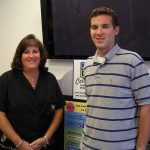In the realm of academia, passion often fuels the pursuit of knowledge and expertise. However, what happens when passion intersects with economic realities and societal demands? In this personal exploration, we uncover the compelling narrative of Linus Yamane, Professor of Economics at Pitzer College, who challenges conventional wisdom by advocating for a shift away from following one’s passions. Drawing on extensive research and firsthand experiences, the professor unveils the harsh realities of income inequality and the pressing need for more Americans to prioritize technical skills over personal passions. Join us as we delve into this thought-provoking journey and unravel the complexities of passion, economics, and societal impact.
The Pursuit of Passion vs. the Imperatives of Economy
Technological change is steadily increasing the demand for technically skilled Americans. We need more computer and math trained people to work in software development and IT security, especially with the remote work spurred by the pandemic. But Americans seem more interested in being “true to themselves” and “following their passions.” The shortage of technically trained Americans results in higher salaries for the technically skilled Americans and explains most of the increase in U.S. income inequality since 2000. (Autor, Goldin, and Katz, 2020) We have increasing income inequality mostly because people are following their passions instead of following the money.
Until 2000 it was enough to get a college education. American college graduates still earn about $1 million more over their lifetime than high school graduates. But since 2000 there are much larger earning differentials among college graduates. College graduates who major in computer science, engineering, economics and physics are earning $2 to $3 million more over their lifetime than theater and studio art majors. (Carnevale, Cheah, & Hanson, 2015) The median salary of a computer science major from Harvey Mudd College is $125K right out of college. These salary differentials among college graduates have been rapidly expanding. But despite these growing wage differentials, not enough students are going into the technical fields. In a market economy, incentives and inequality are two sides of the same coin. We need more students to follow the money rather than their passions.
In majors like computer science, engineering, economics and physics students primarily learn to use mathematics to think rigorously about the world. But in the U.S. less than 20% of college students major in the STEM (science, technology, engineering and mathematics) fields. In countries like Germany, Russia, and India over 30% of college students major in the STEM fields. (UNESCO Institute for Statistics) In the vast majority (68%) of countries around the world a larger share of students major in STEM than here in the U.S. The larger supply of STEM majors in these countries keeps their STEM salaries in check so the returns to a STEM education are much lower. (Hanushek, et. al., 2013) Most U.S. students need not major in STEM. But we should increase the number of STEM majors by about 50% to be comparable with other countries.
We clearly need to make it easier for students to go to college to gain these technical skills. No country in the world charges anywhere near as much for a college education, public or private. We charge over $300K (tuition, room and board) for a B.A. here at the Claremont Colleges. Even with Pell and institutional grants, a U.S. college education is the most expensive in the world. Two-thirds of universities in developed countries charge less than $2,000 in tuition. College tuition is free in countries like Germany, Sweden, and Norway.
We also need to do a much better job in the K-12 years teaching mathematics so that our students are prepared for the more technical majors in college. The Program for International Student Assessment (PISA) shows that 15 year old math skills in the U.S. are well below the OECD (Organization for Economic Cooperation and Development) average. Americans with a high school diploma perform at the level of high school dropouts in other countries. (Rampey, et. al., 2016)
If more U.S. students followed the money rather than their passions, we would have much less income inequality in the U.S. We now have more income inequality in the U.S. than in 69% of countries around the world and 85% of the countries in the OECD. We would have to redistribute almost half of the income in the U.S. in order to achieve income equality.
The rising income inequality is the driving force behind the rising political polarization in the country. The blue states are well- educated, high-income states. The red states are less-educated, lower-income states. For example, the residents of Maryland are twice as likely to have graduated from college than the residents of Mississippi, and the median household income in Maryland is twice as high as in Mississippi. We need to close these enormous education and income gaps.
Too many Americans feel obligated to be true to themselves and to follow their own passions. They work as servers at restaurants here in Los Angeles while going to auditions. They spend hours and hours on basketball courts in the hopes of making it to the NBA. At the same time we have a shortage of Americans with the technical skills to solve today’s problems. The majority (61%) of graduate students in U.S. economics Ph.D. programs are international students because most domestic students don’t have the technical skills. We need more practical Americans seeking out careers with the higher salaries in order to reduce income inequality in the U.S. and make our society more equitable.
References:
- Autor, D., Goldin,C., and Katz, L. 2020. “Extending the Race between Education and Technology.” AEA Papers and Proceedings, 110: 347-51.
- Carnevale, A., Cheah, B., and Hanson, A. 2015. “The Economic Value of College Majors.” Center on Education and the Workforce. Georgetown University.
- Hanushek, E.A., Schwerdt, G. Wiederhold, S. and Woessmann, L. 2013. “Returns to Skills Around the World: Evidence from PIAAC”. NBER Working Paper 19762.
- Rampey, B.D., Finnegan, R., Goodman, M., Mohadjer, L., Krenzke, T., Hogan, J., and Provasnik, S. 2016. “Skills of U.S. Unemployed, Young, and Older Adults in Sharper Focus: Results From the Program for the International Assessment of Adult Competencies (PIAAC) 2012/2014: First Look (NCES 2016-039)”. U.S. Department of Education. Washington, DC: National Center for Education Statistics.






